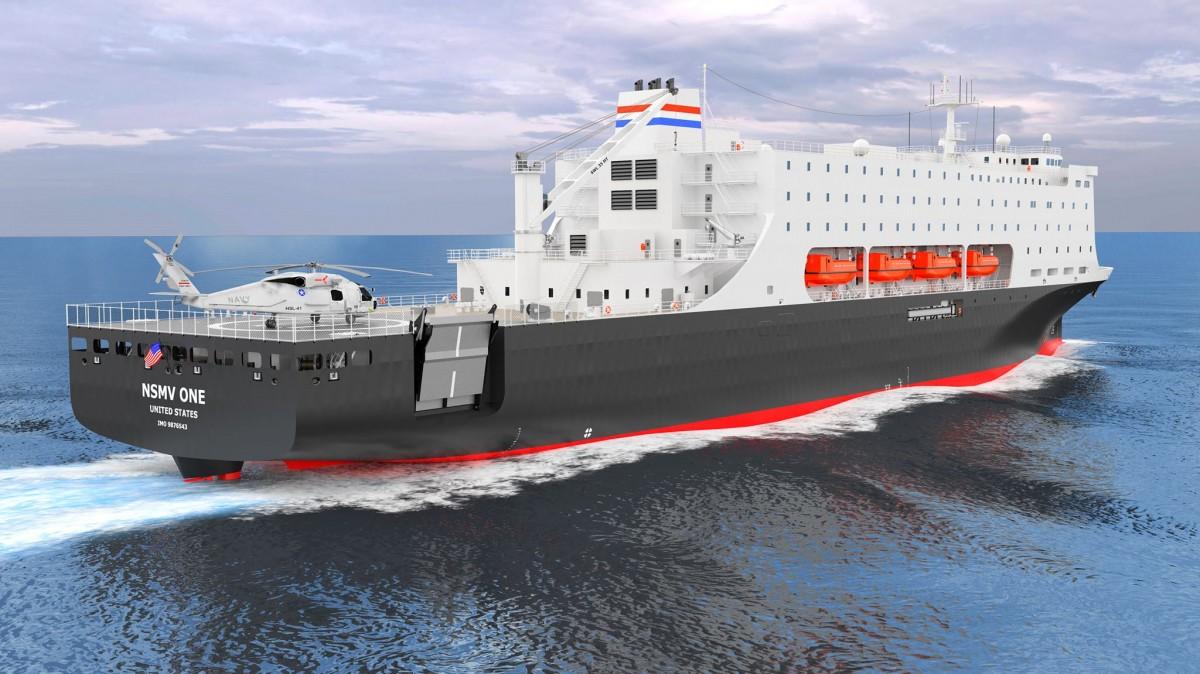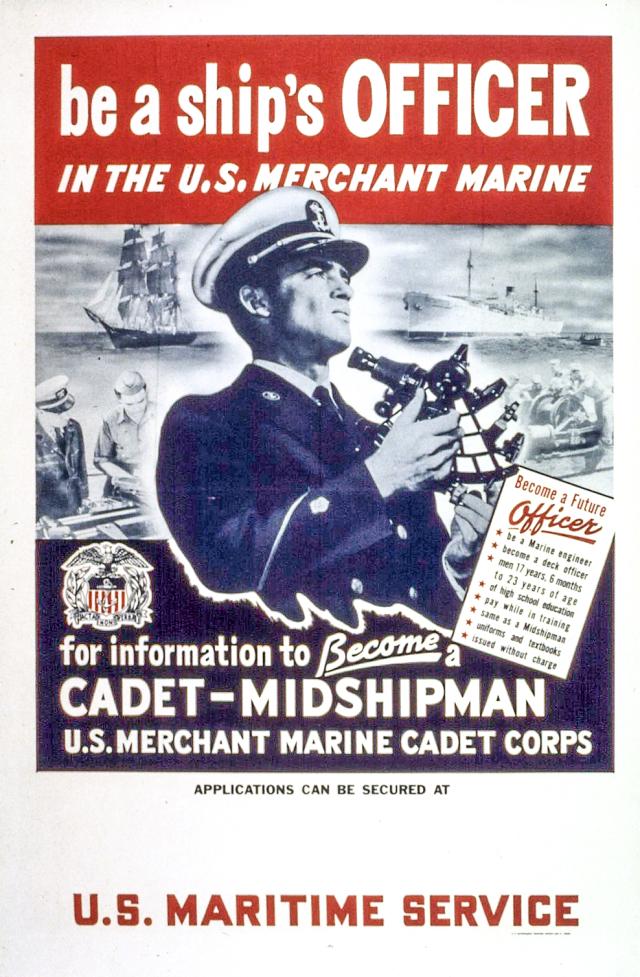The U.S. Merchant Marine Academy (USMMA)—also known as Kings Point— marked the 75th anniversary of its founding as a federal service academy on 30 September 2018. Kings Point alumni from the classes of 1943 to 2018 came to celebrate homecoming weekend and remember the wartime sacrifices of the U.S. Merchant Marine during World War II. At a dinner that weekend the Academy held a candlelight service honoring the 142 Kings Point midshipmen who died in action during the war and a restored stone relief titled The Last Full Measure, engraved with their names, was unveiled in the school’s dining hall.
With their sacrifice in mind, Kings Point alumnus and U.S. Navy Vice Admiral Johnny R. Wolfe, Jr., delivered a call to action:
Globalization makes our world smaller. We’re in an era where the global commerce and security environment is more complex than ever. With roughly ninety percent of all of the world’s commerce and trade done on the seas, it’s imperative that we continue to grow, we continue to develop, and we continue to innovate to maintain our maritime superiority.
There are several aspects of maritime superiority. The U.S. Navy is the most powerful navy in the world, although the edge it enjoys over potential adversaries has dwindled in the past decade. The other key ingredient of maritime superiority is the U.S. Merchant Marine, and, with its number having “declined from 1,288 international trading vessels in 1951 to” a current fleet of only 81 ships, it is in a state of emergency.
The Merchant Marine is charged with carrying supplies and troops for the Department of Defense (DoD) during wartime and carrying cargo for the world during peacetime. The September 2017 maritime workforce report to Congress stated 11,768 qualified U.S. citizen mariners are required to operate and maintain the Military Sealift Command fleet and the U.S.-flagged merchant fleet. This is the exact number of qualified mariners presently available—leaving no margin for sickness or attrition. The United States is no longer among the top twenty maritime nations, with U.S.-flagged vessels earning only two percent of the total maritime revenue. As foreign shipping companies operate more cheaply, and the U.S. struggles to compete, the merchant fleets of Greece, Japan, China, Germany, and Singapore have risen to the top, contributing more than half of worldwide maritime shipping capacity.1
The current Maritime Administration (MARAD) Administrator, Rear Admiral Mark Buzby, commented in a Defense News interview on the present relationship between the U.S. Navy and the dwindling merchant fleet: “The Navy has been candid enough with Military Sealift Command and me that they will probably not have enough ships to escort us [in a wartime scenario]. It’s: ‘You’re on your own; go fast, stay quiet.’”
If the Merchant Marine is to meet its responsibilities of supporting U.S. military forces, then it is time to take three major steps toward a more self-reliant Merchant Marine. It must: promote more employment and training opportunities; change the way it operates with the military; and make long-term investments for the American maritime industry over the next ten years.
Promoting Employment
Captain John Konrad, licensed U.S. Coast Guard (USCG) Master of Unlimited Tonnage, reports that “the public’s understanding of the Merchant Marine and allied Merchant Navies, has dwindled to historically low figures” because “no one advertises the Merchant Marine.” When I talk to civilian friends and acquaintances about the USMMA, too often I receive a response such as, “Oh, you’re going in the Marines?” One time, I was sitting in a waiting room and caught a man staring at me. I was wearing my khaki school uniform with the USMMA logo on it. As the man was called up for his appointment, he walked past me and said, “Semper Fi, brother.”
When I received my appointment to Kings Point last May, I had six weeks to out-process and discharge from the U.S. Army. In those six weeks, I took a week-long course designed to help out-processing soldiers find work, family, and educational resources. As an incoming maritime academy student who knew nothing about the maritime industry, I went into the course intending to find a maritime internship. Two of those days involved a job fair, at which I networked with representatives who advertised apprenticeships, commercial driver’s license training for trucking, and federal government work. However, I found nothing in the maritime domain.
A problem in all military branches is servicemember retention. During that Army course, I met soldiers getting out for a variety of reasons, and every soldier I talked to still had a desire to serve their country. Surely, MARAD and commercial maritime companies can advertise more employment opportunities to service members leaving the military. This strategy would support the military indirectly, by helping build the Merchant Marine. Companies could advertise apprenticeships for work in shipyards, ports, or onboard ships as unlicensed personnel.
Another problem hurting the Merchant Marine is the gender gap in the maritime industry. Despite the Maritime Administration enforcing polices supporting equal opportunity and combatting sexual harassment and assault, integrating women continues to remain a challenge. On most ships with an average crew of twenty-five, two will be women. The traditional, masculine culture onboard ships keeps the industry resistant to integrating women.2
Defense Operations
If the Merchant Marine continues to decline, Air Force General Darren McDew has predicted that the next option in response to “a lengthy, mass deployment on the scale of [Operation] Desert Shield/Desert Storm could eventually require U.S. forces to rely on foreign-flagged ships for sustainment.” The last time this happened was during the 1991 Gulf War, with a fraction of the vessels refusing to deliver cargo to the war zone.3 In addition, Admiral Buzby warns that relying on foreign-flagged ships for DoD operations threatens national security and endangers shipping priority. The challenges to the Merchant Marine in maintaining DoD maritime readiness and investing in self-sustainability raises the question, “What operational changes can be made in the Merchant Marine–DoD relationship to make it better?”
One positive development is the MARAD’s recent request for proposal for a construction manager to oversee building a new class of training vessels known as the National Security Multi-Mission Vessels (NSMVs). This ship design is intended to meet training and teaching needs of the state maritime academies (SMAs), replace their aging ships, and to act as a support vessel for military and first-responders in humanitarian assistance and natural disaster missions. Features in the NSMV include: sixty days of food storage, classrooms, laboratories, fiber-optic networking, medical facilities, cellphone antennas, helicopter landing pads, a cargo crane, and a roll-on/roll-off space with a side ramp for vehicles. The first unit is scheduled for completion in 2022, and it will go to the State University of New York Maritime College (SUNY Maritime).
Mariner Education
In addition to buying new training ships, educating future mariners must be emphasized. A statement on MARAD’s website proclaims, “The education of merchant marine officers is an essential Maritime Administration responsibility to meet national security needs and to maintain defense readiness.” MARAD fulfills this responsibility by providing tuition assistance to SMA cadets through their Student Incentive Payment Program. The military already provides enlisted servicemembers opportunities to receive bachelor’s degrees and a commission through ROTC. Even service academies are offered 170 slots each year for prior enlisted personnel. However, few enlisted men and women know that Kings Point provides its midshipmen the freedom to serve as commissioned officers in any military branch upon graduation. Even fewer know that SUNY Maritime and Kings Point both offer GI-Bill students one of the highest monthly housing allowance rates in the country. So why should MARAD not work with the DoD in this capacity and push to incentivize commissioning as a licensed officer in the Merchant Marine?
At the 2018 Council of American Master Mariners conference, Rear Admiral Michael Rodriguez, Superintendent of the Texas A&M Maritime Academy, addressed his concerns and plans for preparing future mariners, including partnering with other schools. The Domestic Maritime Centers of Excellence Act, signed into law on 12 December 2017, authorizes MARAD to fund community colleges, technical schools, and other educational centers providing training for the domestic maritime workforce, designating these institutions as “Centers of Excellence (CoE).” The CoE Act not only puts some of the new ideas presented here into action, but also allows more public funds and resources to help create new ones.
Schools with culinary arts and hospitality programs can work with maritime academies to create new associate’s and bachelor’s programs for future mariners interested in working on ships in steward departments. CoEs also provide future mariners with diverse work opportunities and internships in science and engineering. For example, I never imagined that space exploration and seafaring had a connection until I learned that the T/V Kings Pointer—Kings Point’s flagship training vessel—was previously owned by the National Aeronautics and Space Administration (NASA) and used in recovering the reusable solid rocket boosters that fell into the ocean after each space shuttle launch. That inspired me to research other spacecraft recovery vessels and to look for internships that apply to both maritime and space exploration.
Finally, CoEs can help prepare mariners for the complex operational environment. As more automated navigation and radar technology is fielded, mariners are losing traditional, useful, seamanship skills such as celestial navigation. Automated vehicles and other technologies are coalescing with transportation and logistics, requiring a collective and creative effort from current and younger generations to create curricula that balance old and new skills.4
Former Chairman of the Joint Chiefs of Staff Army General Colin Powell once said, “We are a maritime nation. We must be able to project power across the seas. This means that not only do we need a strong Navy, but a strong maritime industry as well.”5 As the second decade of the twenty-first century approaches and the polar ice caps melt, the only way the United States can maintain its naval and maritime power is to make its Merchant Marine self-sustainable.
1. United Nations Conference on Trade and Development (UNCTAD), “Merchant Fleet by Beneficial Ownership-2018”, UNCTAD, 31 July 2018, http://unctadstat.unctad.org/EN/Infographics.html#&gid=2018&pid=Fleet%20ownership%2C%202018.
2. Iris Lavalle Acejo and Sanley S. Abila, "Rubbing Out Gender: Women and Merchant Ships," Journal of Organizational Ethnography 5, no. 2 (2016): 123–138, https://search-proquest-com.usmma.idm.oclc.org/docview/1798626796?accountid=42242.
3. Tim Johnson, “Dwindling Merchant Marine Fleet Crimps U.S. Ability to Wage War,” McClatchyDC.com, 14 May 2018, www.mcclatchydc.com/news/nation-world/national/national-security/article210623279.html.
4. “How Do We Prepare the Mariners of the Future?” Sidelights, June 2018, 34–35.
5. “Quotes About American Merchant Marine by Presidents, Military Leaders, National Figures, and Others,” American Merchant Marine at War, 7 January 2008, www.usmm.org/quotes.html#anchor920754




